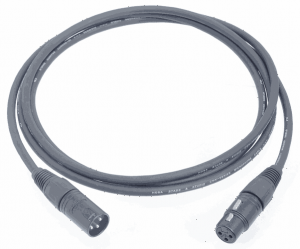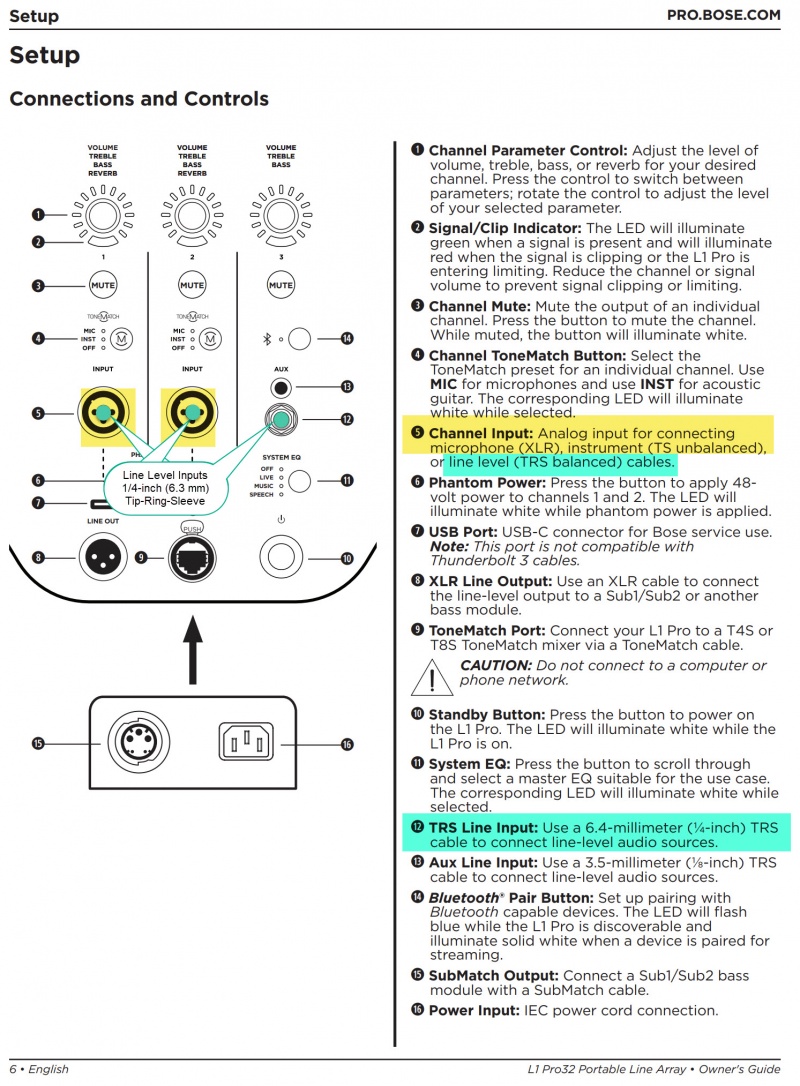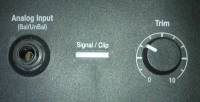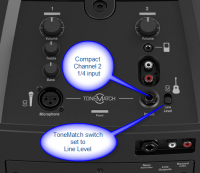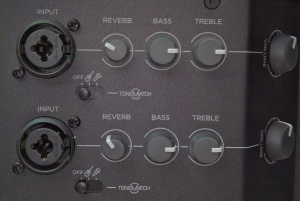XLR
See: XLR Connector at wikipedia
Occasionally known as Cannon connectors.
Microphone Cable
This is a typical microphone cable with male and female XLR connectors. This might also be used to connect a mixer to a PS1 Power Stand (Classic) / Model I.
Related Topics
Introduction
When talking about cables the terms Stereo, Mono, Balanced, Unbalanced refer to applications (how a cable is being used).
XLR, Tip-Ring-Sleeve, Tip-Sleeve are terms that refer to the physical connectors at the ends of the wires and how those wires are attached to the connectors.
It's important to use the correct connections to support your application or you may end up with poor results. For example, if you connect a stereo signal to a balanced input, you may hear very little, or just effects with none of the original signal.
Confusion About Plugs and Jacks
One source of confusion is that a cable with a 1/4 inch (6.35 mm) Tip-Ring-Sleeve jack on one end may be used for several applications (examples)
- Stereo headphones (left and right sides of a stereo signal)
- Mono balanced connection (hot and cold signals)
- Insert (send and return)
Whether or not a cable with a 1/4 inch (6.35 mm) Tip-Ring-Sleeve plug is stereo or balanced (mono) or an insert cable depends on how it is being used and the electronic interfaces at both ends of the connection.
Balanced Connections Preferred When Possible
- If both ends of a connection support balanced connections, then use a balanced cable (3 common options below).
- XLR to XLR
- 1/4 inch (6.3 mm) Tip-Ring-Sleeve
- XLR to 1/4 inch (6.3 mm) Tip-Ring-Sleeve
- Note
An unbalanced connection can be -6 dB lower signal level than a to balanced connection.
Background Information
- A balanced electrical signal runs along three wires: a ground, a positive leg, and a negative leg. Both legs carry the same signal but in opposite polarity to each other. Any noise picked up along the cable run will typically be common to both legs. Assuming the destination is balanced, the receiving device will flip one signal and put the two signals back into polarity with each other. This causes the common noise to be out of phase with itself, thus being eliminated. This noise cancellation is called Common Mode Rejection and is the reason balanced lines are generally best for long cable runs. XLR and Tip-Ring-Sleeve cables are used to transmit balanced audio from one balanced device to another.
- Unbalanced cables are less complicated, but they’re much more susceptible to noise problems. In general, unbalanced lines should be kept as short as possible (certainly under 25 feet) to minimize any potential noise that may be carried with the signal into the connected equipment.
Source: [1]
DO NOT Connect a Stereo Source to a Balanced Input
If you connect a stereo signal to a balanced input, you may hear very little, or just effects with none of the original signal. A balanced input will take the left and right signals from a stereo source and combine them with reversed polarity (this is how balanced connections work). The result is sounds that are panned in the center (typically, vocals, drums, bass) will be cancelled.
Connections between Bose Portable PA Systems
Overview: All Connections are Balanced
All line-level connections between Bose Portable PA systems are balanced***. Where possible, use a 1/4 inch (6.35 mm) Tip-Ring-Sleeve or XLR cable to make a balanced connection. Using an unbalanced connection may lead to up to -6 dB lower signal.
- ToneMatch mixers: The analog outputs (Main and Aux outputs) are balanced
- Power Stands: The 1/4 inch (6.35 mm) Tip-Ring-Sleeve inputs are balanced L1 Model 1S, L1 Model II, L1 Compact channel 2 1/4 inch (6.35 mm) Tip-Ring-Sleeve
- S1 Pro System: The channel 1 and 2 inputs are balanced
- For all Daisy Chain connections, use a balanced connection if possible. Most of the time that will be a 1/4 inch (6.35 mm) Tip-Ring-Sleeve
- ***Exception: All 1/4 inch (6.3 mm) inputs on the L1 Classic/L1 Model I are unbalanced
T4S ToneMatch mixer
- Channels 1, 2, 3, 4 XLR inputs are balanced.
- Channels 1, 2, 3, 4 ¼ inch (6 mm) jacks are balanced
- They will accept 1/4 inch (6.35 mm) Tip-Sleeve jack Tip-Sleeve connections and the connections will be unbalanced.
- Channels 5 and 6 are balanced, but will accept 1/4 inch (6.35 mm) Tip-Sleeve jack Tip-Sleeve.
If you use a 1/4 inch (6.35 mm) Tip-Ring-Sleeve from a balanced source, the connection will be balanced.
If you use a 1/4 inch (6.35 mm) Tip-Ring-Sleeve from an unbalanced source, the connection will be unbalanced.
If you use a 1/4 inch (6.35 mm) Tip-Sleeve from a balanced or unbalanced source, the connection will be unbalanced.
If you have a balanced source then using a balanced connection (XLR or 1/4 inch (6.35 mm) Tip-Ring-Sleeve) is preferable.
T8S ToneMatch mixer
- Channels 1, 2, 3, 4, 5, 6, 7, 8 XLR inputs are balanced.
- Channels 1, 2, 3, 4, 5, 6, 7, 8 ¼ inch (6 mm) jacks are balanced
- They will accept 1/4 inch (6.35 mm) Tip-Sleeve jack Tip-Sleeve connections and the connections will be unbalanced.
- Channels 9 and 10 are balanced, but will accept 1/4 inch (6.35 mm) Tip-Sleeve jack Tip-Sleeve.
If you use a 1/4 inch (6.35 mm) Tip-Ring-Sleeve from a balanced source, the connection will be balanced.
If you use a 1/4 inch (6.35 mm) Tip-Ring-Sleeve from an unbalanced source, the connection will be unbalanced.
If you use a 1/4 inch (6.35 mm) Tip-Sleeve from a balanced or unbalanced source, the connection will be unbalanced.
If you have a balanced source then using a balanced connection (XLR or 1/4 inch (6.35 mm) Tip-Ring-Sleeve) is preferable.
T1 ToneMatch Audio Engine
- Channels 1, 2, 3 XLR inputs are balanced.
- Channels 1, 2, 3 1/4" jacks are unbalanced (but will accept 1/4 inch (6.35 mm) Tip-Ring-Sleeve) the connections are still unbalanced.
- Channels 4/5 are balanced, but will accept ¼ inch jack Tip-Sleeve.
If you use a 1/4 inch (6.35 mm) Tip-Ring-Sleeve cable from a balanced source, the connection will be balanced.
If you use a 1/4 inch (6.35 mm) Tip-Ring-Sleeve cable from an unbalanced source, the connection will be unbalanced.
If you use a &1/4 inch (6.35 mm) Tip-Sleeve cable from a balanced or unbalanced source, the connection will be unbalanced.
If you have a balanced source then using a balanced connection (XLR or ¼ inch jack Tip-Ring-Sleeve) is preferable.
L1 Pro (all models)
L1 Model II
- Model II Power Stand Analog input is balanced.
It will accept ¼ inch jack Tip-Sleeve.
If you use a 1/4 inch (6.35 mm) Tip-Ring-Sleeve cable from a balanced source, the connection will be balanced.
If you use a 1/4 inch (6.35 mm) Tip-Ring-Sleeve cable from an unbalanced source, the connection will be unbalanced.
If you use a ¼ inch jack Tip-Sleeve from a balanced or unbalanced source, the connection will be unbalanced.
If you have a balanced source then using a balanced connection (XLR or ¼ inch jack Tip-Ring-Sleeve) is preferable.
L1 Model 1S
- Model II Power Stand Analog input is balanced.
It will accept ¼ inch jack Tip-Sleeve.
If you use a 1/4 inch (6.35 mm) Tip-Ring-Sleeve cabe; from a balanced source, the connection will be balanced.
If you use a 1/4 inch (6.35 mm) Tip-Ring-Sleeve cable from an unbalanced source, the connection will be unbalanced.
If you use a 1/4 inch (6.35 mm) Tip-Sleeve cable from a balanced or unbalanced source, the connection will be unbalanced.
If you have a balanced source then using a balanced connection (XLR or ¼ inch jack Tip-Ring-Sleeve) is preferable.
L1 Compact
Compact Channel 2 1/4 inch (6.35 mm) Tip-Ring-Sleeve input is balanced.
It will accept 1/4 inch (6.35 mm) Tip-Sleeve cables.
If you use a 1/4 inch (6.35 mm) Tip-Ring-Sleeve cable from a balanced source, the connection will be balanced.
If you use a 1/4 inch (6.35 mm) Tip-Ring-Sleeve cable from an unbalanced source, the connection will be unbalanced.
If you use a 1/4 inch (6.35 mm) Tip-Sleeve cable from a balanced or unbalanced source, the connection will be unbalanced.
If you have a balanced source then using a balanced connection (XLR or 1/4 inch (6.35 mm) Tip-Ring-Sleeve cable) is preferable.
S1 Pro System
S1 Pro Combo Inputs 1/4 inch (6.35 mm) Tip-Ring-Sleeve jack and XLR are balanced.
They will accept 1/4 inch (6.35 mm) Tip-Ring-Sleeve or 1/4 inch (6.35 mm) Tip-Sleeve jacks.
If you use a 1/4 inch (6.35 mm) Tip-Ring-Sleeve cable from a balanced source, the connection will be balanced.
If you use a 1/4 inch (6.35 mm) Tip-Ring-Sleeve cable from an unbalanced source, the connection will be unbalanced.
If you use a 1/4 inch (6.35 mm) Tip-Sleeve from a balanced or unbalanced source, the connection will be unbalanced.
If you have a balanced source then using a balanced connection (XLR or 1/4 inch (6.35 mm) Tip-Ring-Sleeve) is preferable.
References
Unbalanced vs. Balanced Lines - Whirlwind
Interconnection of Balanced and Unbalanced Equipment Bill Whitlock, Jensen Transformers.
Sound System Interconnection RaneNote 110
Balanced, Unbalanced, Stereo? what are they? Sweetwater.com > Frequently Asked Questions
Balanced vs Unbalanced Interconnects audioholics.com
What's the Difference Between Balanced and Unbalanced aviom.com
